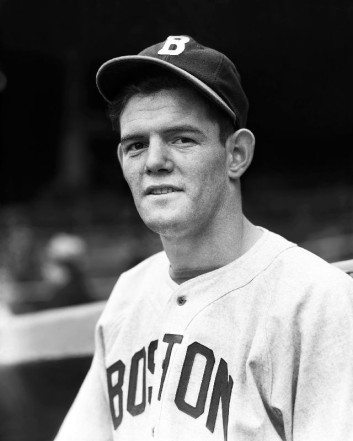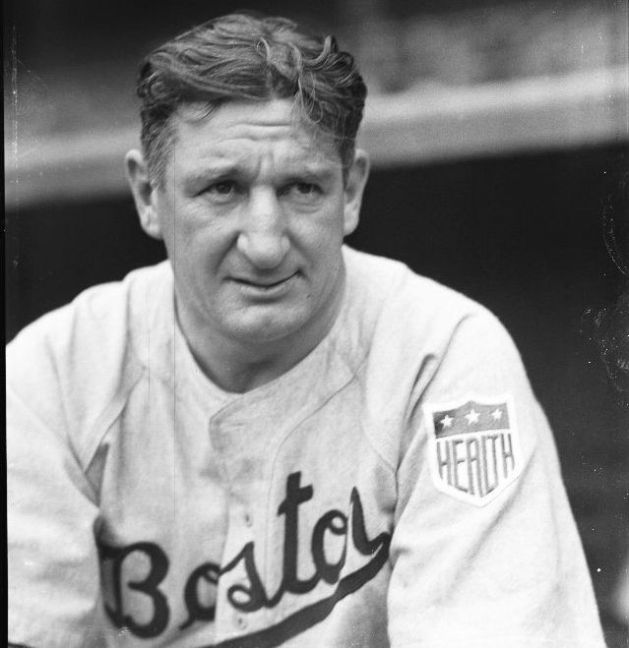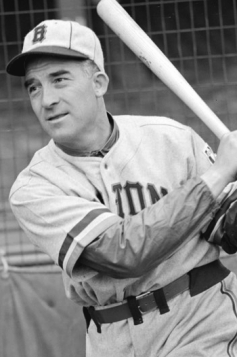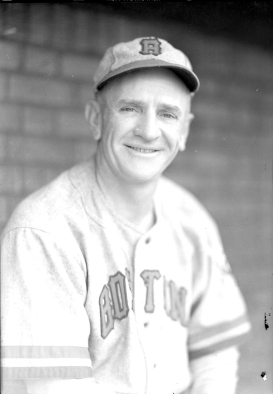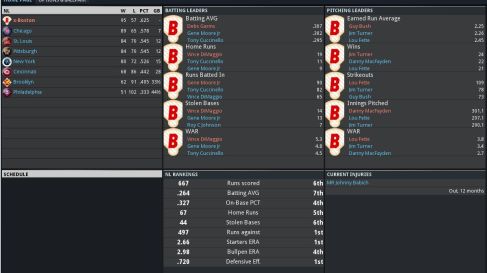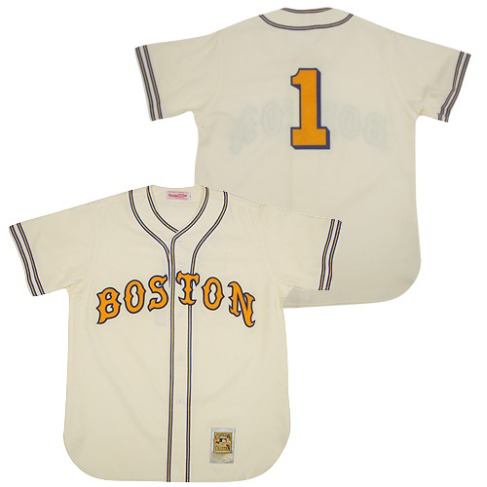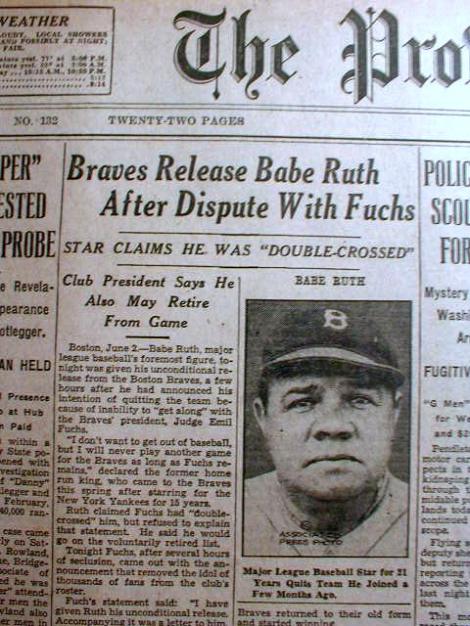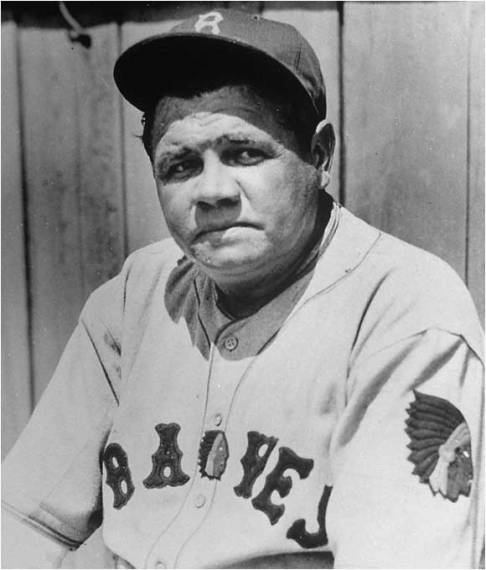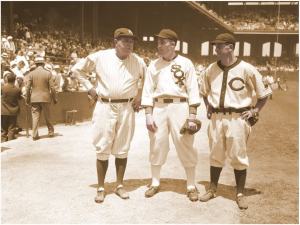Longest post ever
1948 – The Braves win the Pennant!
Boston Braves finish 91-62-1, first in NL
The Braves had been setting themselves up with a lot of talent over the past couple of years, and continued to this year – trading for second baseman Eddie Stanky, bringing up their new starting shortstop Al Dark (NL Rookie of the Year in 1948,) and in mid 1947 they traded for pitcher Bill Voiselle. All of these players would help them win the pennant this year but none of them would stay with the Braves very long afterwards. This would be the first time the Braves won the NL pennant since their World Series winning season of 1914.

The famous photo of the 1948 Braves season, Spahn on the left and Sain on the right.
This season is always associated with Spahn and Sain and their excellent pitching, but looking at it now it’s clear that while Sain was absolutely amazing this year, Spahn was only good, not great. Given Spahn’s greatness to come it may seem wrong to criticize his 1948 performance (15-12, 3.72 ERA) but in fact that was his highest ERA until 1964. He and Sain certainly had their moments, especially the one which led to the famous lines written by Boston Post sports editor Gerald Hern:
First we’ll use Spahn
then we’ll use Sain
Then an off day
followed by rain,
Back will come Spahn
followed by Sain.
And followed
we hope
by two days of rain.
It started with a Labor day doubleheader, where Spahn won the first game in a 14 inning complete game win, and Sain the second with a shutout. Following two off days, it did rain. Spahn won the next day, and Sain won the day after that. Three days later, Spahn won again. Sain won the next day. After one more off day, the two pitchers were brought back and won both ends of another doubleheader. All in all, Sain and Spahn were 8-0 in 12 days. In fact though, the rest of the Braves’ rotation, Bill Voiselle and Vern Bickford also pitched pretty well this year.
All-Stars
Eddie Stanky, 2B

Eddie was traded from the Dodgers to the Braves this year and was a solid utility infielder, mostly at second base. He played for a lot of teams during his career, and appeared in three different World Series, but never won. Stanky was a notoriously tricky player who would do anything to win and was especially known for his ability to draw walks, leading the NL in walks three times and in OBP twice. One of his famous tricks (which led to a rule change banning it) was as a baserunner on third with less than two out, he would stay back from the base several steps into left field, and when any outfield fly was hit, he would time it so he could start running, step on the bag just as the ball was caught and be running at full speed for home, easily beating any throw. After his playing career was over, he managed in the majors and minors, and eventually was the manager of the University of South Alabama’s baseball team for many years.
Bob Elliott, 3B
Bob had another great year for the Braves, though not quite as good as his 1947 performance. He had 23 home runs, 100 RBIs, 131 walks (a career high) and hit .283, finishing with a .897 OPS. He would go on to play well for the Braves for three more seasons and another All-Star appearance.
Tommy Holmes, OF
Tommy has been with the Braves since 1942 and won one previous All-Star nod, in 1945. He hit .325 this year and would never has as good of a hitting season again. Tommy was a fan favorite, especially by those of the bleachers behind right field where he played – he was known to carry on conversations with fans during games. Tommy was also known during his career for being amazingly difficult to strike out (love to see that in the current Braves.) I actually found that by one measure he might have been the fourth most difficult guy to strike out in baseball history – in his career he had 5,565 plate appearances and only struck out 122 times.
Phil Masi, C
Phil split catching duties in 1948 with Bill Salkeld but was mostly the starter – the last season he would start for the Braves. Phil has been with the Braves sine 1939 and with all their player movement has been one of their regulars. He became especially known for a play in Game One of this year’s World Series – while on second as a pinch runner (yes a catcher as a pinch runner) in the eighth inning of a scoreless pitcher’s duel, Bob Feller tried to pick him off. It looked to almost everyone like Lou Boudreau had put the tag on him but the umpire called him safe. Tommy Holmes then hit a single which scored Masi, giving the Braves a run which proved the clincher in a 1-0 win. The controversy of this play would follow Masi to the end of his career, so much so that when he died in 1990 his will stated that yes, he had really been out on that play.
Masi being tagged out at second by Lou Boudreau
Johnny Sain, P
Johnny had the best year of his career in 1948 as he led the Braves to the pennant, winning twenty-four games and losing fifteen, with a 2.60 ERA.He led the league in wins, games started, complete games (28) and innings pitched and finished as second in Most Valuable Player voting but lost to Stan Musial’s absolute wrecking ball of a season with the Cardinals. (For those interested, Stan hit .376, had 39 home runs, 131 RBIs, .450 on-base percentage, OPS of 1.152.) It wouldn’t be until 1956 that pitchers got their own separate Cy Young award, though Sain did win the Sporting News NL Pitcher of the Year Award this year, which was established in 1944 and continues to this day.
1948 World Series
The 1948 OOTP Braves finished at 92-61 and won the NL pennant as they should have, and played the Indians as they did in real life. However the Indians swept the Braves in the World Series in OOTP, unlike in real life when Cleveland won in 6.
The Braves won Game 1 1-0 as I described earlier, with a Sain-Feller pitching duel going the whole way. The Indians’ Bob Lemon defeated Warren Spahn in Game Two, 2-0 and Cleveland went on to win games three and four at home. Spahn defeated Feller in Game Five in Cleveland, 11-5, and it would return to Boston for a final chance. World Series pitching became integrated for the first time when Satchel Paige pitched for the Indians in relief in Game 5. The Braves’ hopes were dashed, however, when Bob Lemon defeated Bill Voiselle in Game 6, 4-3 and Cleveland won the Series.

Larry Doby, first black player in the American League, pounded the Braves in the 1948 World Series, hitting .313.
The World Series had appeared on television in a limited basis the previous year, and now with Cleveland involved, the use of television was extended – this series was the first World Series to be viewable aboard a train, and in the days of separate TV networks in the Northeast and Midwest, something had to be done so that fans of both teams would be able to watch all the games. So a remarkable experiment was tried – called Stratovision, a special B-29 was rigged up so it could fly over Pennsylvania and “bounce” a TV signal from a Pittsburgh studio, enabling a large area of the midwest to view Game 6 of the World Series. It had its limits, and in the end additional connector cables were laid the next year so that the World Series was viewable from a much farther area.











